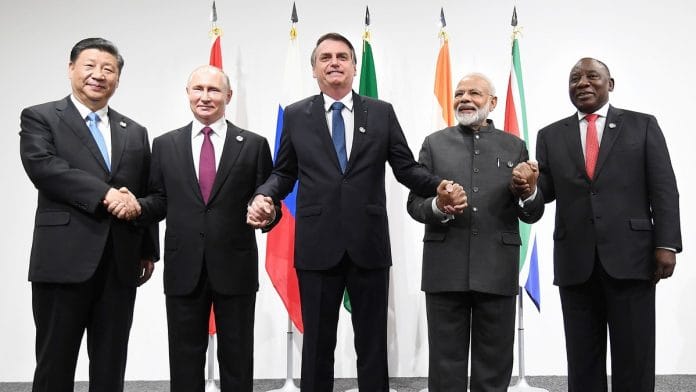Preparations are on for the 11th BRICS summit, to be held in Brazil in November 2019. Developments in global trade and protectionist policies provide good reasons for BRICS countries to expedite their trade and investment cooperation. But there are many obstacles.
The way forward can be paved by putting a greater emphasis on increasing private sector and citizen involvement. The BRICS nations need to move towards a bottom-up approach to increase cooperation among them.
This could involve a single BRICS visa, removing visa requirements for member nations, inducing increased collaboration among researchers and orchestrating private sector collaboration.
Multipolar alternative to US-Europe
BRIC — Brazil, Russia, India and China — was formed in 2006 as a coalition of four fast growing countries who supported a multipolar alternative to a US-Europe dominated international financial and governance system. They belonged to three continents and extended their coverage to the African continent by adding South Africa to the association in 2010.
Since 2009, these countries have met annually and increased the scope of their association far beyond the initial effort to new areas such as energy, terrorism and research.
Among the many steps to increase trade and investment among BRICS nations, the most important was the BRICS Development Bank, later named the New Development Bank that was proposed by India at the New Delhi summit in 2012.
It is sometimes felt that the BRICS are too diverse, have little in common and have no shared history. They have emerged merely owing to the coinage of the term BRIC in a Goldman Sachs report in 2001. The association did not die away or become irrelevant, but despite the many steps taken towards greater cooperation, these nations, which represent an emerging economy perspective, did not become a cohesive group.
Also read: In face of Donald Trump’s protectionist push, BRICS bats for multilateral trade
Economic potential and challenges
The potential for becoming an economically-powerful bloc lies in the fact that the BRICS have about 40 per cent of the world’s population, about a fourth of the world’s GDP and about a fifth of world trade. The opportunities for collaboration in trade, investment and energy are huge.
The BRICS are globally major players in manufacturing, agriculture and services. These spheres provide opportunities for collaboration. They include two big oil and gas producers, Russia and Brazil, and two big consumers, India and China. They are all regional powers. They feel that their role in global governance is should be bigger. Each stands against a West-dominated international economic and financial system.
Yet, despite the opportunities and the potential, intra-BRICS trade and investment flows are very low. Imports and exports among BRICS nations are low. FDI flows to and from the BRICS are mainly to other countries and not to each other. China dominates whatever little flows happen within the BRICS nations.
Traditional solutions to increasing trade and investment like free trade agreements, investment treaties and a common currency are much discussed among the academic forums. Yet, pre-conditions such as mutual trust are not fulfilled yet.
China’s presence in Africa in the energy sector is outside the BRICS. India has concerns about its large trade deficit with China and its Belt and Road initiative.
It is premature to talk about an FTA among member countries when no two members have a bilateral investment treaty. Local currency-denominated trade as a response to dollar-dominated trade is another often-made proposal, but there is no consensus when details are discussed. The Chinese effort to internationalise the renminbi and to replace the dollar for trade will further increase the dominance of China, and is not acceptable to all members.
Also read: India and South Africa sign 3-year strategic action plan to enhance ties
The way forward
While governments make annual statements on the need to increase cooperation, and how they are committed to increase trade and investment flows, the underlying fundamental state-controlled systems in most of the BRICS nations have restricted discussions of greater trade and investment mainly to top-down initiatives.
The BRICS association has mainly been an inter-governmental system with limited interactions between the private sector and citizens. Government-sponsored think-tanks are unable move away from the state-defined national agenda.
To go forward, the association will have to create common interest groups with shared visions, lobbying for common changes and removal of restrictions. Very different political systems will continue to act as constraints, but there is little that the BRICS as an association can do about that. It has to take these political differences as given and accept the fact that this is likely to imply slower and lower cooperation.
While the vision for the BRICS may be, in the end, an EU-type model with free movement of goods, services, labour and capital, we are a long way from there. Limited resources, increasing trade protectionism, and lack of trust among members make it difficult to reach this destination.
In the meantime, a strategy needs to be developed to increase people-to-people interaction. One initiative to increase private sector and citizen involvement in BRICS as a concept is to encourage bottom-up collaborations. This can be facilitated by allowing collaboration by freeing up movement across the BRICS for businessmen, researchers, tourists, students and ultimately all citizens by easier visa regimes. A single BRICS visa for citizens of the BRICS countries wishing to visit each other can pave the way for removal of visa requirements for BRICS passport holders.
The commitment to collaboration requires this as a first step. It is a necessary condition for creating people-to-people connect and building mutual trust and common interests.
The author is an economist and a professor at the National Institute of Public Finance and Policy. Views are personal.
Also read: BRICS nations urge other countries to prevent terror financing







BRICS should implement free trade agreement